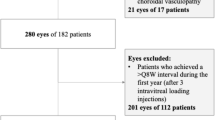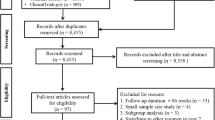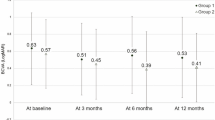Abstract
Aims
The aim of this study is to evaluate the effect of standard-fluence verteporfin photodynamic therapy (PDT) delivered on the first day of a ranibizumab regimen for choroidal neovascularisation secondary to age-related macular degeneration compared with ranibizumab monotherapy.
Methods
Patients were randomised to sham or standard-fluence verteporfin PDT at baseline. The first of three monthly loading doses of ranibizumab was given on the same day, and thereafter patients received monthly treatment with ranibizumab as required. All patients underwent monthly visual acuity and OCT assessment and 3-monthly fluorescein angiography with follow-up to 1 year.
Results
In all, 18 patients were recruited. The PDT group gained a mean of 2.2 ETDRS letters at 1 year and the sham group gained a mean of 4.4 letters (P=0.47). Both groups required a mean of 1.3 injections of ranibizumab following the 3-month loading phase. Fluorescein angiography at 1 month demonstrated marked choroidal hypoperfusion in all patients treated with PDT with reduced choroidal perfusion persisting to month 12. This did not occur in the sham group.
Conclusion
The addition of standard-fluence verteporfin PDT at baseline to a ranibizumab regimen conferred no benefit in terms of visual acuity or number of ranibizumab injections required at 1 year. The combination of these treatments resulted in persistent reduced choroidal perfusion, which raises potential safety concerns.
Similar content being viewed by others
Log in or create a free account to read this content
Gain free access to this article, as well as selected content from this journal and more on nature.com
or
References
Mitchell P, Korobelnik J-F, Lanzetta P, Holz FG, Pruente C, Schmidt-Erfurth UM et al. Ranibizumab (Lucentis) in neovascular age-related macular degeneration: evidence from clinical trials. Br J Ophthalmol 2010; 94 (1): 2–13. Published Online First: 20 May 2009, doi:10.1136/bjo.2009.159160.
Spaide RF . Rationale for combination therapy in age-related macular degeneration. Retina 2009; 29 (6 Suppl): S5–S7.
Shah GV, Sang DN, Hughes MS . Verteporfin combination regimes in the treatment of neovascular age-related macular degeneration. Retina 2009; 29: 133–148.
Heier JS, Boyer DS, Ciulla TA, Ferrone PJ, Jumper JM, Gentile RC et al. Ranibizumab combined with verteporfin photodynamic therapy in neovascular age-related macular degeneration: year 1 results of the FOCUS Study. Arch Ophthalmol 2006; 124: 1532–1542.
Schmidt-Erfurth U, Wolf S, PROTECT Study Group. Same-Day administration of verteporfin and ranibizumab 0.5 mg in patients with choroidal neovascularisation due to age-related macular degeneration. Br J Ophthalmol 2008; 92: 1628–1635.
Kaiser PK, Registry of Visudyne AMD writing committe. Verteporfin photodynamic therapy combined with intravitreal bevacizumab for neovascular age-related macular degeneration. Ophthalmology 2009; 116 (4): 747–755.
Guidelines for Intravitreal Injections Procedure 2009. http://www.rcophth.ac.uk/about/publications/. (accessed on 21 May 2010).
Pruente C, Hatz K, Henrich PB, Braun B, Sacu S, Schneider U . A randomised double-masked study comparing lucentis monotherapy and pdt combined with lucentis therapy in patients with exudative amd: one year results for bcva and retreatment frequency. Presented at ARVO May 2009, abstract athttp://arvo.abstractsonline.com/plan/SSResults.aspx. (accessed on 13 September 2009).
Schmidt-Erfurth UM, Michels S . Changes in confocal indocyanine green angiography through two years after photodynamic therapy with verteporfin. Ophthalmology 2003; 110: 1306–1314.
Piermarocchi S, Sartore M, Lo Giudice G, Maritan V, Midena E, Segato T . Combination of photodynamic therapy and intraocular triamcinolone for exudative age-related macular degeneration and long-term chorioretinal macular atrophy. Arch Ophthalmol 2008; 126 (10): 1367–1374.
Kiss CG, Simader C, Michels S, Schmidt-Erfurth U . Combination of verteporfin photodynamic therapy and ranibizumab: effects on retinal anatomy, choroidal perfusion and visual function in the PROTECT study. Br J Ophthalmol 2008; 92: 1620–1627.
Schmidt-Erfurth U, Kiss C, Sacu S . The role of choroidal hypoperfusion associated with photodynamic therapy in neovascular age-related macular degeneration and the consequences for combination strategies. Prog Retin Eye Res 2009; 28: 145–154.
Acknowledgements
We acknowledge Ms S Patra for her contribution as one of the assessors of fluorescein angiograms in this study and we also like to acknowledge the dedication of all the Clinical Research Unit staff at Bristol Eye Hospital. This study was funded by a block grant from Novartis UK.
Author information
Authors and Affiliations
Corresponding author
Ethics declarations
Competing interests
CC Bailey and MA Majid have received travel funding to attend ophthalmic conferences from Novartis UK.
Rights and permissions
About this article
Cite this article
Vallance, J., Johnson, B., Majid, M. et al. A randomised prospective double-masked exploratory study comparing combination photodynamic treatment and intravitreal ranibizumab vs intravitreal ranibizumab monotherapy in the treatment of neovascular age-related macular degeneration. Eye 24, 1561–1567 (2010). https://doi.org/10.1038/eye.2010.84
Received:
Revised:
Accepted:
Published:
Issue date:
DOI: https://doi.org/10.1038/eye.2010.84
Keywords
This article is cited by
-
Predictors of 1-year visual outcome in OCT analysis comparing ranibizumab monotherapy versus combination therapy with PDT in exsudative age-related macular degeneration
Wiener klinische Wochenschrift (2016)
-
Single-session photodynamic therapy combined with intravitreal ranibizumab for neovascular age-related macular degeneration: a comprehensive functional retinal assessment
Documenta Ophthalmologica (2013)



